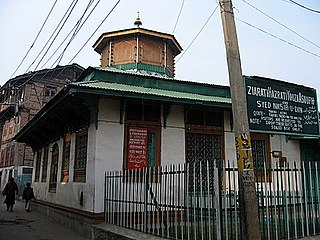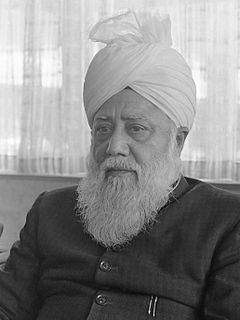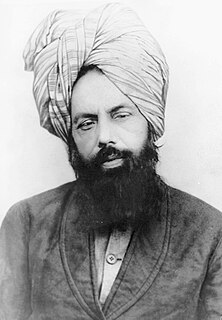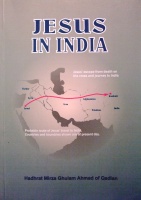
The Ahmadiyya movement believe that Jesus survived The Crucifixion and migrated eastward towards Kashmir to escape persecution. He went on to spread his message to the Lost Tribes of Israel after he had carried out his mission to the Israelites in Judea. Living to old age, he later died a natural death in Srinagar, Kashmir.

The Ahmadiyya Caliphate is a non-political caliphate established on May 27, 1908 following the death of Mirza Ghulam Ahmad, the founder of the Ahmadiyya Muslim Community, who claimed to be the promised Messiah and Mahdi, the expected redeemer awaited by Muslims. It is believed by Ahmadis to be the re-establishment of the Rashidun Caliphate that commenced following the death of the Islamic prophet Muhammad. The caliphs are entitled Khalīfatul Masīh, sometimes simply referred to as Khalifa. The caliph is the elected spiritual and organizational leader of the worldwide Ahmadiyya Muslim Community and is the successor of Ghulam Ahmad. He is believed by the Community to be divinely ordained and is also referred to by its members as Amir al-Mu'minin and Imam Jama'at. The 5th and current caliph is Mirza Masroor Ahmad.

al-Barāhīn al-Ahmadīyyah 'alā Haqīqatu KitābAllāh al-Qur'ān wa'n-Nabūwwatu al-Muhammadīyyah is a five-part book written by Mirza Ghulam Ahmad, the founder of the Ahmadiyya Movement. The first two parts were published in 1880 CE, the third volume was published in 1882, the fourth volume in 1884 and the fifth volume in 1905. In writing the book, Ghulam Ahmad sought to rejuvenate Islam by arguing for the validity of its principles and vindicating its teachings in response to Christian and Hindu polemics against Islam as well as atheistic philosophies. In this context, a significant portion of the subject matter of the book is dedicated to the defence of Islam as a whole against the criticism of Muhammad, the Qur'an and Islam that was raised in the 18th and 19th centuries predominantly by Christian missionaries and Hindu revivalists.

The Roza Bal or Rouza Bal or Rozabal is a shrine located in the Khanyar quarter in Downtown area of Srinagar in Kashmir, India. The word roza means tomb, the word bal mean place. Locals believe a sage is buried here, Yuzasaf or Yuz Asaf, alongside another Muslim holy man, Mir Sayyid Naseeruddin.
Ahmadis, are followers of Mirza Ghulam Ahmad. They comprise two subsects, the Ahmadiyya Muslim Community and the Lahore Ahmadiyya Movement.

Mirza Tahir Ahmad was the fourth caliph and the head of the worldwide Ahmadiyya Muslim Community. He was elected as the fourth successor of the founder of the community Mirza Ghulam Ahmad on 10 June 1982, the day after the death of his predecessor, Mirza Nasir Ahmad.

Hāfiz Mirza Nasir Ahmad was the third caliph, head of the Ahmadiyya Muslim Community. He was elected as the third successor of Mirza Ghulam Ahmad on 8 November 1965, the day after the death of his predecessor and father, Mirza Basheer-ud-Din Mahmood Ahmad.

Mirza Basheer-ud-Din Mahmood Ahmad, was the second caliph, leader of the worldwide Ahmadiyya Muslim Community and the eldest son of Mirza Ghulam Ahmad from his second wife, Nusrat Jahan Begum. He was elected as the second successor of Mirza Ghulam Ahmad on 14 March 1914 at the age of 25, the day after the death of his predecessor Hakim Nur-ud-Din.

Hakeem Noor-ud-Din was a close companion of Mirza Ghulam Ahmad, the founder of the Ahmadiyya Movement, and was chosen as his first successor on 27 May 1908, a day after his death, becoming the first caliph and leader of the worldwide Ahmadiyya Muslim Community. He was a renowned physician, writer, theologian, and an expert in Arabic and Hebrew.

Mirza Masroor Ahmad is the current and fifth caliph, and leader of the worldwide Ahmadiyya Muslim Community. He was elected as the fifth successor of the founder of the movement—Mirza Ghulam Ahmad—on 22 April 2003, three days after the death of his predecessor Mirza Tahir Ahmad, the fourth Caliph of the Ahmadiyya Muslim Community.

Malfūzāt translated as the dialogues, discourses or spoken words is a five volume corpus of the sayings of Mirza Ghulam Ahmad of Qadian, the founder of the Ahmadiyya movement in Islam, who claimed to be the Promised Mahdi and Messiah. These discourses were written down by his companions. The volumes cover a period of nearly two decades of Ghulam Ahmad's discourses, speeches, question and answer sessions, sermons and conversations starting from 1891 until his death in 1908. To date, only a small portion has translated into English.

Mirza Ghulam Aḥmad was a religious figure from India, and the founder of the Ahmadiyya Muslim Community. He claimed to be the Mujaddid of the 14th Islamic century, the promised Messiah, and the Mahdi awaited by the Muslims in the end days. He declared that Jesus (Isa) had in fact survived the crucifixion and later died a natural death, after having migrated towards Kashmir and that he had appeared in the likeness of Jesus.

Jesus in India is a treatise written by Mirza Ghulam Ahmad, the founder of the Ahmadiyya Movement in 1899. The treatise, which was then published as a book, puts forward the view that Jesus survived crucifixion, left Judea and migrated eastward in order to continue his mission to the 'Lost Tribes of Israel', traveling through Persia and Afghanistan and eventually dying a natural and honourable death in Kashmir at an old age. Ghulam Ahmad applied textual analysis of both the Gospels and Islamic sources – the Quran and hadith – and also drew upon medical and historical material, including what he claimed were ancient Buddhist records, to argue his case. Although independent modern scholars such as Norbert Klatt (1988) have rejected Ghulam Ahmad's use of these latter sources as misreadings of material unrelated to Jesus.
Bahishti Maqbara, located originally in Qadian, India and then in Rabwah, Pakistan is a religious cemetery established by the Ahmadiyya Community as a directive from the community's founder Mirza Ghulam Ahmad, made known in his booklet Al-Wasiyyat. Mirza Ghulam Ahmad established it in his will after he saw an angel showing him the place of his burial.

The Promised Reformer Day is celebrated by Ahmadi Muslims annually on 20 February in remembrance of the prophecy concerning the birth of an "illustrious son" to Mirza Ghulam Ahmad whom the Ahmadis regard as the Promised Messiah and Mahdi, and its fulfilment in the person of Mirza Bashir-ud-Din Mahmud Ahmad, the second Caliph of the Ahmadiyya Muslim Community. It is not a celebration of Mahmud Ahmad's birth which occurred on 12 January, but rather the commemoration of the prophecy and its fulfilment in his person.

The timeline of Ahmadiyya history began in 1889 when the Ahmadiyya Muslim Community was established in Qadian, a village of India. It is now a worldwide community consisting of members from over 200 nations.

Pandit Lekh Ram was a hindu leader known for his encounters with the founder of the Ahmadiyya Muslim Community Mirza Ghulam Ahmad. He also wrote a book in falsification of Ahmad's Barahin-e-Ahmadiyya and named it Takzeeb e Barahin Ahmadiyya. He was assassinated on March 6, 1897. Ahmadis claim this was in accordance with the prophecies of Mirza Ghulam Ahmad.

The Ahmadiyya movement in Islam has relationships with a number of other religions. Ahmadiyya consider themselves to be Muslim, but are not regarded as Muslim by mainstream Islam.














